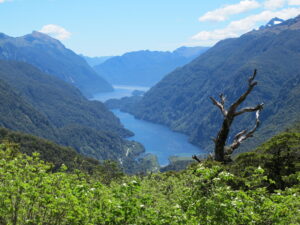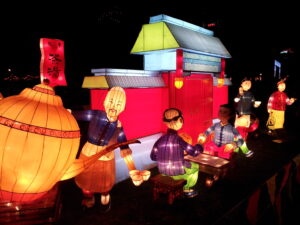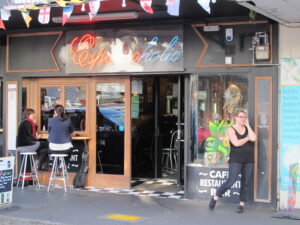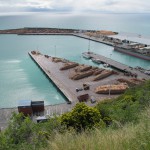
We stood on the edge of the bulky rock bluff looming over the town of Napier and abutting the extensive arc of shoreline within Hawke’s Bay and the Pacific Ocean. Below us, tractors snatched pine logs and eased them out of their pincers into neat rows for shipment to Asian markets. To the left, newer housing spread to far hills over a flat land occasionally broken up with lagoons. But, to our right, largely hidden from view, lay the essence of Napier, dual passions forged from the violent earthquake of 1931: the decorous central city rebuilt after the destruction, and the broad plains upheaved by the quake, rich with soil perfect for fine winemaking.
New Zealand’s deadliest earthquake, a 7.8 temblor centered just 10 miles away, knocked down or burned up almost everything but this bluff, killing hundreds here and flattened virtually every building.
Painting the Town

The city rose again over the next few years, not looking back to nineteenth century styles, but turning to the contemporary appeal of art deco. The result today throughout the central city, even where jarring signage mars the effect, is a diverse and attractive display of the many colors and whimsies of art deco. It’s a cool pastel smorgasbord, of creams and crystal blues, ochre and peach, charcoal and rose. Nor is the city dully uniform, for each building found its own character and influences. Amid the overall patterned and geometric approach, you can see stylized Egyptian elements common in cinemas of the time, echoes of classical Greece in such features as abstracted columns, designs from traditional Maori carvings, Spanish mission and Moorish influences, even shamrocks.

The rebuilding at the time spanned over a half dozen blocks long and three blocks deep plus the riverfront gardens; eighty years later, the renovating of buildings continues. The most notable one we saw was the Municipal Theatre, brought back to its former glories around fifteen years ago. The exterior was attractive enough, but we hoped at least to peek into the box office area. As we entered, a slight energetic man of 50-something years hailed us and immediately offered to show us around. He was a sort of facilities manager, not even a regular guide, but he enthusiastically reviewed with us the highlights of the theatre: the somewhat Mondrian-like rectangles intersecting on the golden lobby carpet, rewoven anew from the best samples remaining; the colorful friezes of headlands under the Southern Cross constellation; its innovative and still functional neon lighting from 1938.
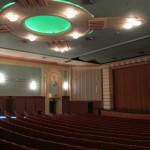
He gleefully opened the doors to the acoustically fine auditorium and pointed out the original wood seats (with new cushions), the sinuous Beardsley-like female figures celebrating women’s equality and suffrage. “The naked figure was controversial at the time, and represented their freedom, though we men have been suffering ever since,” he quipped slyly. And as the final touch, he fired up the large inverted dome on the ceiling so we could admire how its recessed lighting shifted through a range of pastel colors.
When we thanked him warmly for time he took to guide us, he said he was always pleased to host people who cared for the delights of this old theatre, as much as he did.
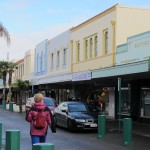
The local citizens clearly have a passion for art deco and their town’s beauty. With little modesty, they call Napier the “art deco capital of the world” and each February (i.e., the summer down here) host a huge celebratory festival honoring all things deco and thirties. Except for that darn signage and some other incongruous oddities, you can see that landlords and shops try to cohere with the overall style.
While standing on a main street just before leaving, we started up a conversation with one resident who suspended what he was doing to talk with us. After a bit of questioning on our politics, he commented that the global recession kept hitting locals hard. Still you can see that the city eagerly continues to invest in its allure. It’s no wonder that, during the day, its art deco streets buzz with shoppers and cafe-goers at a typically relaxed Kiwi pace and, as we saw at night, sees people shaking things up some more.
Grapier Napier
Not only did the 1931 earthquake lead to new buildings, but it literally created the conditions for a wine industry. Thousands of acres of land around Napier rose up above sea level, as much as two meters (and apparently has kept rising since). That upheaval apparently filled in the wetlands with soil just right for producing wines full of character.
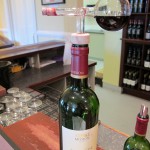
Just as in California, missionaries enthusiastically brought wine production as well as religious teaching to the Hawke’s Bay area. In 1851, the French Marist brothers decided that laboring in the fields would be healthful, plus helpful in producing both sacramental and table wine. Their seminar building still stands, though moved chunk by chunk a century ago to its current location. It serves as the tasting rooms and headquarters of the ongoing Mission Winery now managed by their successors – for “non-profit” as our ebullient server kept underscoring while encouraging us to purchase bottles.
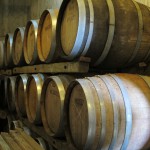
After the great heave, the few Hawke’s Bay vintners made some false starts with grape types not quite congenial for the region. Finally, they turned to rich reds – especially Merlot, Cabernet Sauvignon and Syrah – and the industry started barreling along. Now about a hundred wineries here produce quite a variety of fine wines out of the sprawling crazy quilt of terroirs that the sea left behind – such as a favorite sub-region of ours known as Gimblett Gravels.
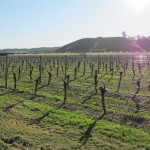
Just as in Napa and Sonoma, dozens of wineries are open for touring. You could visit them on your own, but we did not hesitate to hire one of the tour companies, Odyssey NZ, to take us around. From previous experience, we knew that driving ourselves was a bad idea after wine tasting at a handful of wineries. Further, there turned out to be three great advantages. First, we were well instructed on the subtleties of good wine tasting by our driver Gareth, a true enthusiast steeped in the aromas of blackberry, marmalade and pepper sniffed from the glass. Second, he pruned the options down to some very passionate winemakers, large and small, besotted with the subtleties of their craft. As a result, the liquid flowed along with their elaborate descriptions of the wines: the four vintners on our tour insisted we try six to ten wines each.

And, lastly, as we too became somewhat besotted with the wines, we made some new friends of our three fellow tasters – a Canadian lawyer and a cheery couple from Mackay, Australia, whom we hope to visit when we get to that country.
Down from the solid rocky bluff, we found the city of Napier – battered flat eighty years ago, but now risen back up – adorned with those twin passions forged by the earthquake, its pastel style and its reddened vats.
(And for more pictures from New Zealand, CLICK HERE to view the slideshow at the end of the New Zealand itinerary page.)



